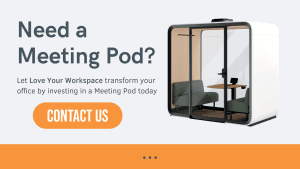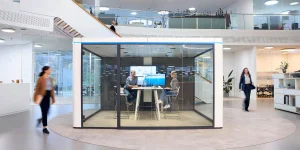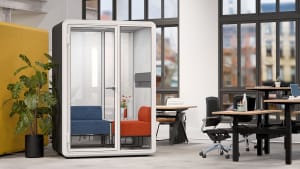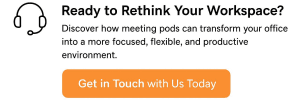As the way we work continues to evolve, so too does the design of our office environments. One of the standout innovations in recent years has been the rise of meeting pods. But what makes meeting pods such a game-changer, and how can businesses get the most out of them?
To explore this further, we spoke to two industry experts, Ben Slade and Barry Foley, who specialise in pods for two separate companies. In this post, they share their insights on the growing popularity of meeting pods, the practical considerations for choosing the right one, and how these compact spaces are helping businesses support focused work and collaboration alike.
Section 1: Practical Questions Answered
This section is all your basic, everyday questions about what a pod is.
How much space does a meeting pod take up?
Now this question varies very much on the size of pod you need, the smallest pods on the market are the single person phone booths. At the other end of the market, pods can go up to, commonly, 8 people however they can also be done larger. “There is a pod for all eventualities from one person to an 8 person and more” says Ben Slade. For Koplus, on the small end of their products is a 1m x 1m Pod, perfect for an employee needing a bit of seclusion for phone calls or Zoom calls. These pods range all the way up to a 8-12 person. Sedus have their smallest pod at 1 x 1.5m. This means you are not only further away from the screen during video calls, which is more flattering, but also you can then fit a fully functional task chair within the pod meaning that the person will be set in the correct posture. This then ranges all the way up to again their larger pods which can hold 8 or more depending on the layout and environment the pod is in.
Barry also highlighted an often overlooked but crucial factor: the height of a meeting pod. While most people focus on floor space—measured in square metres or square footage—it’s just as important to consider the cubic volume. This is particularly relevant for ventilation. Many pod systems draw in air from above the unit, so if there’s less than 200mm clearance between the top of the pod and the ceiling, it can create a heat pocket. As a result, warm air is circulated back into the pod—far from ideal for user comfort.
Is it fixed to the floor or walls, or freestanding?
Most meeting pods are freestanding, which not only makes them easier to relocate or dismantle but can also offer tax advantages, as they’re typically classified as furniture rather than fixed structures. Sedus pods, for example, feature a built-in floor with adjustable jacks at each corner, making them simple to move and re-level—whether you’re repositioning within the same office or transporting them to a new location. Koplus takes a slightly different approach: their booths are mounted on casters with levelling feet, allowing them to be rolled into place and then stabilised once in position. This allows them to be easily relocated with whatever changes you are making to your office.
What are the access requirements for delivery and installation?
Both companies explained that their pods are designed to be easily transported, with components that break down to fit through a standard doorway. While having a lift is certainly helpful—especially for installations on higher floors—it’s not essential, as the parts can be carried up if needed. For detailed installation requirements or access considerations, it’s always best to speak directly with your chosen supplier, who will be happy to guide you through the process.
Does it meet fire safety regulations?
In short, yes—meeting pods are designed to comply with fire safety regulations. From internal wall linings to considerations like sprinkler placement, the Approved Document B (ADB) outlines the relevant guidance and recommendations for fire safety in and around pods. Barry Foley has provided a PDF summary, written by Peter Long, of the key ADB guidelines, which you’ll find below. It’s worth noting that while manufacturers like Koplus and Sedus don’t handle sprinkler installation themselves, they can connect you with trusted suppliers and professionals to ensure your setup meets all necessary compliance standards.
What kind of warranty or guarantee is included?
Koplus and Sedus both offer a standard 5-year warranty. A 5-year warranty means the manufacturer guarantees that the product will be free from defects in materials or workmanship for five years from the date of purchase. If something goes wrong due to a manufacturing fault during that time, they will typically repair or replace it at no cost. This gives you peace of mind that the product is built to last. However, the lifespan of a pod depends on the materials it’s made from.
Section 2: Functionality and Features
Is it soundproof?
While no pod is completely soundproof, both Sedus and Koplus offer high levels of acoustic privacy—designed to significantly reduce background noise and prevent conversations from being overheard. Barry also made an important point during our discussion: meeting pods can’t be completely soundproof, as this would prevent users from hearing fire alarms and other essential safety signals. Instead, they’re designed to significantly reduce noise while still allowing critical alerts to be heard. These pods are ideal for phone calls, focused work, or confidential meetings. The level of sound insulation can vary by model, so it’s worth checking the acoustic performance data, especially if the pod will be placed in a busy or open-plan office.
All testing for noise levels surrounding pods is done externally meaning that numbers are not generated in house and can be a reliable way to differentiate sound levels from pods.
There are two measures that are used to measure the amount of sound in a pod. Here’s a quick explanation:
- dB stands for decibel, a unit that measures the intensity of sound.
- dB(A) is a weighted decibel measurement that reflects how the human ear hears sound—giving less weight to very low and very high frequencies, which we don’t hear as well.
In the context of meeting pods, dB(A) levels can be used in two ways:
- Background noise levels inside the pod – e.g., how quiet it is inside during use.
- Speech level reduction – how much the pod reduces the volume of sound passing in or out, often measured using ISO 23351-1.
Does it come with lighting, power sockets, or ventilation?
Yes, most modern meeting pods come fully equipped with LED lighting, power outlets, and ventilation systems as standard. Sedus pods, for instance, include energy-efficient lighting and discreet airflow systems that keep the air fresh without being noisy. Koplus pods come with integrated lighting and a quiet ventilation system that refreshes the air every few minutes—making them comfortable even during longer meetings or calls.
On that note, Ben Slade explained that Sedus pods come with an occupancy-sensitive light as standard, which clearly indicates when the pod is in use. This feature can also be integrated with an online booking system, making it easy for larger organisations to manage pod availability and allow staff to pre-book the space when needed.
Can it be used for video calls without echo or background noise?
Speech level reduction is measured in decibels (dB) and typically refers to how much sound is blocked from entering or exiting the pod. Most high-quality pods achieve a reduction of around 28–35 dB, which significantly lowers the chance of conversations being overheard. These figures are usually tested to ISO 23351-1, the standard for speech privacy in furniture systems. In practice, this means someone just outside the pod would hear muffled noise, but not clear words—ideal for confidential chats or calls. Similarly, Barry informed us that pods can also be equipped with an RJ45, which means that telephone connections don’t have to go through Wi-Fi for companies needing additional privacy during phone conversations.
Is it wheelchair accessible?
Accessibility varies by model, but both Sedus and Koplus offer pod options that meet DDA (Disability Discrimination Act) and Equality Act guidelines. Many models have low thresholds or ramp options, wide doorways, and enough internal space for a wheelchair to turn comfortably. If accessibility is a priority, it’s worth discussing specific requirements with the supplier to ensure the chosen pod meets your needs.
Section 3: Design and Aesthetics
What finishes and colours are available?
Meeting pods aren’t just practical—they can also be a beautiful addition to your workspace. Both Sedus and Koplus offer a wide range of finishes, fabrics, and colours to suit different office styles. Whether you prefer soft, neutral tones or bold, statement colours, there are plenty of options to match your aesthetic. Sedus, for example, provides a broad palette of upholstery and panel finishes.
Koplus places a strong emphasis on customisability. Because their pods are constructed from steel, they can be wrapped in vinyl—much like how cars are wrapped—allowing for an almost limitless range of design options without impacting stock levels or lead times. This means companies can enjoy both speed and flexibility when ordering. Barry also shared a particularly creative feature: the use of magnetic vinyl wraps, which can be easily swapped out depending on the season, a campaign, or even to celebrate something like an “Employee of the Month.” It’s a clever way to keep the office environment fresh and engaging.
Similarly, Sedus offers the option to vinyl wrap their pods to reflect specific branding or creative themes. Ben shared some standout examples—including one pod designed to look like a beer can for a brewery office, and another styled as a classic red telephone box for the AA. These custom wraps allow businesses to turn a functional space into a bold brand statement. As Ben put it, “If you can dream it, we can put it on a pod.”
Can it match our existing office furniture and/or branding?
Yes—customisation allows you to align your meeting pod with your company’s existing branding or furniture scheme. From fabric colours and frame finishes to interior furniture choices, suppliers often work closely with clients to create a cohesive look. This is especially useful in branded environments or client-facing areas where first impressions matter. Sedus, in particular, offers coordinated design options across its entire range of office furniture for a fully integrated feel.
What makes your pods different from others / why buy your pods?
This was the last question that we asked both of our experts. This was an opportunity to describe what makes them different in a now very saturated market.
Barry says:
There are three key reasons why Koplus stands out in a crowded market.
First, their pods are made from steel, making them exceptionally durable and long-lasting—built to withstand the demands of busy office environments.
Second, they offer excellent reliability, backed by a 5-year warranty and close collaboration with their trusted manufacturing partners in Taiwan. These pods are built to last.
Third, Koplus has a distinct advantage when it comes to lead times. By keeping their pods in stock and using a vinyl wrapping system for custom finishes rather than ordering bespoke materials, they can offer faster delivery without compromising on choice.
Ben said:
With around 94 meeting pod manufacturers now active in the UK market, it’s easy to feel overwhelmed by choice. But what sets Sedus apart is a clear and consistent focus on sustainability and transparency. They’re open about how their acoustic performance is tested and how they work with clients to create spaces with the ideal sound environment. Ben also highlighted the extensive customisation options as a major selling point, with a wide range of finishes to suit different styles and branding needs. Another thoughtful detail is their slightly deeper phone booth design, which allows for the full recline of an ergonomic chair—a small but meaningful feature for user comfort, especially during longer sessions.
Conclusion
Meeting pods are more than just a trend—they’re a practical, stylish solution to the challenges of modern office design. Whether you’re looking to improve privacy, reduce noise, or create a space for focused work, pods from manufacturers like Sedus and Koplus offer thoughtful design, excellent functionality, and flexibility that scales with your business.
The industry experts we interviewed were from two separate companies. Ben Slade works for Sedus, whose meeting pods combine German engineering with sleek, modular design. Barry Foley works for Koplus, known for their user-friendly design—offering a range of pods that are easy to install, highly functional, and ideal for focused work or video calls.
Need help choosing the right pod for your space? Get in touch and we’d be happy to help you explore the options.
A Special Thank You
We’d like to extend a heartfelt thank you to Barry Foley from Koplus and Ben Slade from Sedus for generously sharing their time, knowledge, and insights. Their expertise has been invaluable in helping us explore the practicalities, functionality, and creative possibilities of meeting pods. We truly appreciate their contributions and ongoing support in helping businesses create better, more flexible workspaces.







